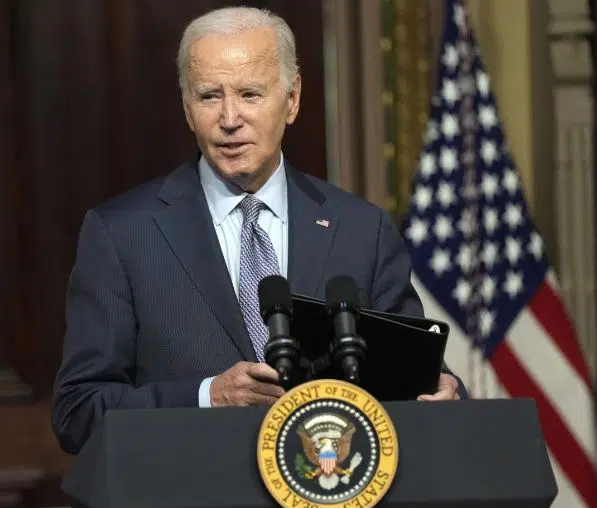WASHINGTON (AP/KFGO) — Clean-energy projects in seven states – including a North Dakota and Minnesota-based hub – have been selected by the Biden administration for a $7 billion program to kickstart development and production of hydrogen fuel, a key component of President Joe Biden’s agenda to slow climate change.
His goal is to establish seven regional hydrogen hubs to help replace fossil fuels such as coal and oil with cleaner-burning hydrogen as an energy source for vehicles, manufacturing and generating electricity.
The White House calls clean hydrogen “essential to achieving the president’s vision of a strong clean energy economy” and net-zero greenhouse gas emissions in the U.S. by 2050.
“As a clean fuel, hydrogen complements the role played by other clean energy sources, like wind and solar, to help the U.S. reduce emissions in energy-intensive sectors of the economy: steel and cement production, heavy-duty transportation, and shipping,” the White House said in a statement.
The seven hubs selected by the administration will spur more than $40 billion in private investment and create tens of thousands of good-paying jobs, the White House said, including many high-paying union jobs. There were 23 finalists for the hydrogen fuel program.
The Minnesota-based Heartland hub seeks to decarbonize fertilizer used in agriculture and advance use of clean hydrogen in electric generation and for cold climate space heating. It also plans to offer equity ownership to tribal communities and local farmers.
Senator John Hoeven says that, with private sector investment, the project will bring $5 billion in investment to regional energy producers, $2 billion of which will benefit a Dickinson renewable diesel facility.
“(The project) not only supports energy production, but expands the market for our soybean producers. That’s because we’ve tied in the ADM crush plant at Spiritwood, which provides feedstock to the Dickinson refinery, while also utilizing carbon capture, utilization and storage to provide low-carbon fuel for the West coast,” Hoeven said. “At the same time, the hydrogen produced will be used for urea and anhydrous ammonia, providing lower-cost fertilizers from a local source for our farmers instead of importing it from Malaysia.”
North Dakota Gov. Doug Burgum applauded the announcement. The Heartland hub was selected for up to $925 million in funding to advance a regional clean energy project involving collaboration among the states of North Dakota, Minnesota, Montana and Wisconsin. Governors of the four states signed a memorandum of understanding in October 2022 to develop the regional hub.
“Clean hydrogen can play a major role in our all-of-the-above energy approach, and we’re grateful to the Department of Energy for recognizing our states’ expertise in agriculture and energy production that will make the Heartland Hydrogen Hub a world-class partnership,” Burgum said. “North Dakota is already an energy and ag powerhouse, and we’re excited to build on our reputation as states that feed and fuel the world with environmental stewardship and a focus on innovation over regulation to meet our nation’s evolving energy needs.”
The University of North Dakota’s Energy & Environmental Research Center (EERC), Marathon Petroleum Corp., TC Energy and Xcel Energy are leading development of the Heartland hub. Marathon and TC Energy also are engaged with the Mandan, Hidatsa and Arikara Nation and Sumitomo Corp. of Americas to participate.
Senator Kevin Cramer said North Dakota is a leader in developing and deploying innovative clean energy technologies which leverage fossil and renewable resources.
“Through the leadership of the Energy and Environmental Research Center at the University of North Dakota, today’s announcement further solidifies North Dakota as a national leader in the energy and agricultural economy of the future,” Cramer said. “By joining with leading strategic partners…the Heartland Hydrogen Hub stands to play an integral role in diversifying the upper Midwest’s fertilizer supply and providing a reliable source of hydrogen for energy applications.”
Nearly every state had joined at least one proposed hub, and many have been working together, hoping to reap the economic development and thousands of jobs they would bring. Big fossil fuel companies, renewable energy developers and researchers in university and government labs are involved, too. The projects selected are based in California, Washington, Minnesota, Texas, Pennsylvania, West Virginia and Illinois.
The infrastructure law Biden signed in 2021 included billions of dollars to develop clean hydrogen technology that industry and clean-energy advocates have long pushed as a way to reduce planet-warming greenhouse gas emissions produced by fossil fuels.
Some environmentalists are skeptical, calling hydrogen a false solution because it frequently relies on natural gas or other fossil fuels as feedstocks. They argue that while hydrogen is a clean-burning source of power, it takes a great deal of energy to produce. When it’s made with electricity from coal or natural gas, it has a bigger carbon footprint than simply burning the source fuel.
“Hydrogen is another bait-and-switch from an administration that continues to break its promises to aggressively tackle climate change and help communities achieve a just, equitable transition to renewable energy,” said Silas Grant, a campaigner with the environmental group Center for Biological Diversity.
Energy companies say fossil fuels can serve as feedstocks if the projects capture the carbon dioxide produced and keep it out of the atmosphere, a technology that has yet to be produced at commercial scale.
States and businesses have been competing for federal dollars in the new Energy Department program, which will create regional networks of hydrogen producers, consumers and infrastructure. The intent is to accelerate the availability and use of the colorless, odorless gas that already powers some vehicles and trains.




